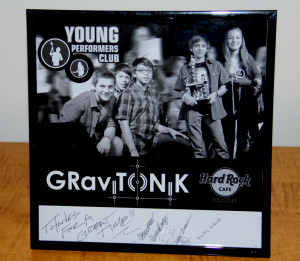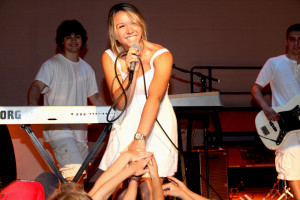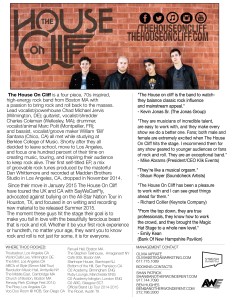As you pursue performance opportunities, you will meet a lot of people that manage the shows, venues and events you are participating in. These people work hard to organize the performance opportunities, so any appreciation you can show them, will be remembered. Many of these organizations are non-profit entities and many events are managed by teams of volunteers who are passionate about helping the young performer market. Whether it is a single event or a longer term relationship, taking the extra step to say thank you, and express in some manner your appreciation, is extremely important. We recently received a framed photograph of a band from CT, Gravitonik, that participated in the Young Performers Club 13 and Under Showcase. The photograph was signed by all the band members and it was accompanied by a nice note thanking us for the opportunity to perform in the event. This type of thank you is extremely rare. It demonstrated that the band genuinely appreciated the opportunity and that they loved being part of a quality event. If the relationship is longer, you may need to be more creative, so your thank you has more emotion and thought behind it. Relationships in the music industry are usually short-term due to school and other committed activities, but every relationship can have value in your future. Not sending a proper thank you can result in you not being recommended for future events.
Saying thank you for opportunities presented you don’t pursue is also important. If you are contacted for a performance opportunity, stating “I am not available” is not acceptable. It is best to state how much you appreciate the opportunity, and that you would have loved to perform in the event if you didn’t have another commitment. A response like the one below is more appropriate as it keeps the door open for future opportunities.
“This event sounds great, and I would have loved to have performed. Unfortunately, I have another performance that evening. Please keep me in mind for future events as we would love to get involved with your organization.”
In saying “I am not available”, it sounds like you simply are not interested. In this scenario, the event manager may not contact you for future events.
It is a small music community in the young performer market, so establishing your reputation early will favorably impact your career development.
Look at the thank you as an opportunity to continue to promote your brand. If you send or post a flyer, as an example, it is possible it will get reposted on the event’s social media pages.
Some ideas for ways you can say thank you follow.
- Sending a framed photo of the performer at the event
- Sending a handwritten note. Get some custom stationery for this purpose
- Posting an appreciation and thank you flyer on your social media sites
- Sending a CD of original music if available
- Sending a tweet about the event
- Sending a promotional item (t-shirt, hat, wristband)
- Posting a review online about the event
- Sending an invitation and ticket to a future event you are performing at
- Sending a note along with your performance schedule
- Sending a small gift ($5-$15)
- Sending a flyer you have created on your performance
- Sending a flyer with the lyrics from one of your original songs and have it signed by the band members
- Bring a small token of your appreciation to the event. If it is a seasonal time, you can provide something that is festive such as a decorated pumpkin, small plant or basket of sweets
Saying “thank you” is all a part of the marketing process. It helps your brand, shows you are respectful and professional and it keeps you connected to the organizations and event managers presenting opportunities. If you get in the habit of taking a few extra minutes to say “thank you”, people will take you seriously and will not hesitate to call you again.







